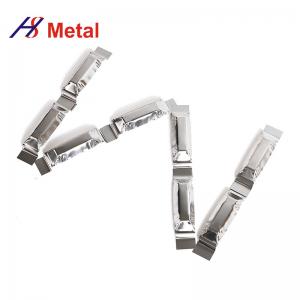
Add to Cart
Description:
Material and Manufacturing: Tungsten boats are typically fabricated from high-purity tungsten sheet or foil. The tungsten metal is processed through precision machining or forming techniques to create boat-like structures with defined shapes and dimensions.
Application: Tungsten boats find application in various industries and research fields. Some common uses include:
Evaporation: Tungsten boats are often employed in vacuum evaporation processes. The boat is loaded with a material (such as metals or compounds) that needs to be heated to a high temperature in a vacuum chamber. As the material vaporizes, it deposits onto a substrate, forming thin films or coatings.
Sample Preparation: Tungsten boats are used in laboratories for sample preparation and analysis. They can hold samples during high-temperature treatments, such as thermal decomposition or annealing.
Electron Microscopy: Tungsten boats can be used as specimen holders in electron microscopy techniques. They provide a stable platform to mount samples for observation and analysis under high-resolution electron microscopes.
Heating Elements: Tungsten boats can also serve as heating elements in certain applications. They can be electrically heated to generate high temperatures in specialized equipment, such as furnaces or high-temperature chambers.
Features and Characteristics: Tungsten boats possess several key features:
High Melting Point: Tungsten has an exceptionally high melting point, allowing tungsten boats to withstand extreme temperatures encountered during evaporation or heating processes.
Good Thermal Conductivity: Tungsten boats exhibit excellent thermal conductivity, ensuring efficient heat transfer from the boat to the material being evaporated or heated.
Chemical Inertness: Tungsten is relatively inert, providing good resistance to chemical reactions and corrosion. This attribute allows tungsten boats to be used with various materials without contamination or degradation.
Mechanical Stability: Tungsten boats offer mechanical stability and can retain their shape and structural integrity under high temperatures and vacuum conditions.
Specifications:
| Chemical Symbol | W |
| Atomic Number | 74 |
| Atomic Weight | 183.84 g/mol |
| Melting Point | 3,422 degrees Celsius (6,192 degrees Fahrenheit) |
| Boiling Point | 5,555 degrees Celsius (10,031 degrees Fahrenheit) |
| Density | 19.3 g/cm³ |
| Crystal Structure | Body-centered cubic |
| Hardness (Mohs) | 7.5 |
| Young's Modulus | 411 GPa |
| Tensile Strength | 550-620 MPa |
| Coefficient of Expansion | 4.5 x 10^(-6) K^(-1) |
| Thermal Conductivity | 173 W/m·K |
| Electrical Conductivity | 30% IACS (International Annealed Copper Standard) |
| Specific Heat Capacity | 0.13 J/g·K |
| Resistivity | 5.6 μΩ·m |
| Magnetic Properties | Paramagnetic |
